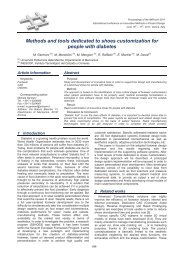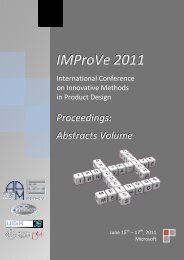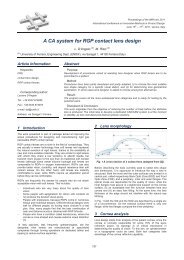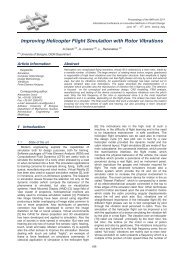IMProVe 2011 - Proceedings
IMProVe 2011 - Proceedings
IMProVe 2011 - Proceedings
Create successful ePaper yourself
Turn your PDF publications into a flip-book with our unique Google optimized e-Paper software.
Engineering Methods in Medicine<br />
Development of procedures aimed at assisting lens designer when RGP lenses are to be<br />
prescribed to a patient.<br />
Method:<br />
Procedures have been partly developed and partly adapted, (i) to choose the most<br />
suitable lens shape category for a specific visual defect, and (ii) for determining lens<br />
geometrical parameters. In some cases lens designer is asked to choose among two<br />
alternatives.<br />
Result:<br />
The program covers all the more widespread lens categories and is ready for testing by the<br />
potential users.<br />
Discussion & Conclusion:<br />
This work originates from the objective of reducing the number of trials before the<br />
definitive lens is produced. The initial idea to develop a dedicated CAD/CAM system is at<br />
the moment in standby, as lens manufacturers distrust optician solutions.<br />
Keywords: DSS, contact lens design, RGP contact lenses<br />
Corresponding Author: Luciano D’Angelo<br />
Tel.: +39 0532 974885<br />
Fax.: +39 0532 974870<br />
e-mail: dal@unife.it<br />
Address: via Saragat 1 Ferrara.<br />
Shape modeling and analysis of a human eye based<br />
on individual experimental data<br />
S. Giovanzana (a), G. Savio (a), R. Meneghello (a), G. Concheri (a)<br />
(a) DAUR – Laboratory of Design Tools and Methods in Industrial Engineering, University of Padova, Italy<br />
Abstract:<br />
Purpose:<br />
The aim of this work is to develop a virtual environment for modeling and analysis an<br />
individual virtual eye which is able to integrate the modern imaging techniques as input<br />
data.<br />
Method:<br />
The virtual environment is developed in a 3D CAD by means of specific plug-ins due to the<br />
ability of this software to manage freeform surfaces and to the simplicity in the scripts<br />
implementation.<br />
Result:<br />
Spot of confusion analysis has been performed on two virtual eyes, with data derived from<br />
literature and by topography measurements.<br />
Discussion & Conclusion:<br />
June 15 th – 17 th , <strong>2011</strong>, Venice, Italy<br />
121<br />
<strong>IMProVe</strong> <strong>2011</strong> - <strong>Proceedings</strong>










